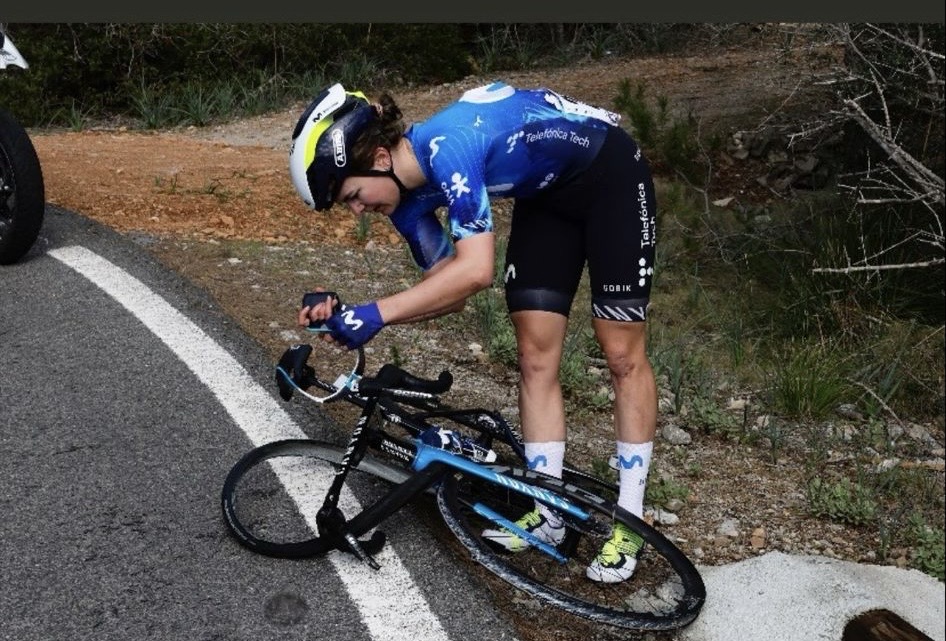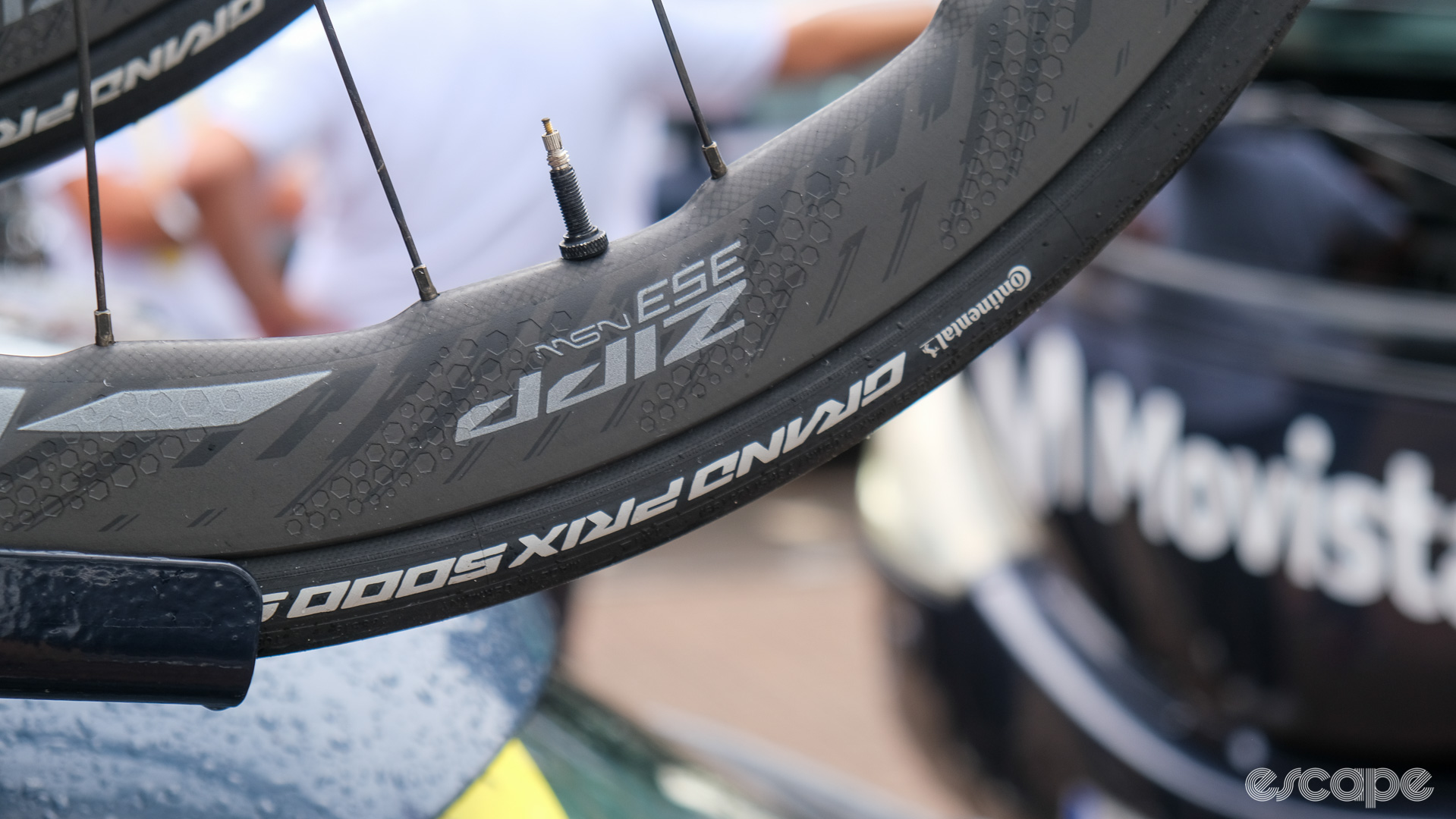It never rains but it pours, the old saying goes. That must have been how Zipp, Lotto Dstny, and Vittoria felt on Saturday evening as photos emerged on Strade Bianche’s official Instagram account of Lotto Dstny rider Johannes Adamietz carrying his bike with the front tyre seemingly blown off the rim and the tyre insert a tangled mess. The front wheel was in a remarkably similar state to that of his teammate Thomas De Gendt’s after his UAE Tour crash just nine days earlier, a crash that sparked worldwide debate on the merits and safety of Tubeless Straight Side (aka hookless) in road.
In short, if it’s been raining this week, it’s been pouring ... sealant. Amidst all the theory and speculation back and forth between hookless supporters and detractors, Lotto Dstny washed their hands of any responsibility due to being “100% within the rules." The UCI announced a study on the use of hookless as "a matter of urgency," while Vittoria and Zipp both blamed a rock as the cause of De Gendt’s crash. That's a rock that no one has seen, not even De Gendt himself. Nor did Lotto Dstny reply to our enquiries as to how team management established an object on the road that caused the incident.

So many theories, only one known fact
As the back-and-forth debate rages on, there remains the simple fact that De Gendt’s tyre width and rim width are not compatible with the ISO’s new standards (which specifically mention Tubeless Straight Side), as first reported by Escape Collective following De Gendt’s crash. We have covered much of the specifics of hookless and the ISO standards in that article, publishing excerpts from ISO 5775-1-2023 for the first time, so we will not go into all those details again. But in summary, the ISO standard states a minimum stamped tyre width of 29 mm with internal rim widths of 24 and 25 mm.
In other words, 23 mm is the maximum internal rim width recommended for use with a tire with a 28 mm stamped size. De Gendt was racing with a stamped 28 mm tyre and 25 mm internal-width rim, which is two millimetres wider than ISO recommends. Multiple sources Escape Collective has spoken with over the past year told us this standard was decided upon following investigations into failures relating to 28 mm tyres on 25 mm internal-width rims.
Whatever the official explanation for De Gendt's crash, this rim and tyre combination certainly didn't help. There are of course countless riders worldwide who have reported zero issues in running 28 mm tyres on 25 mm rims, but as the maxim goes, “absence of evidence is not evidence of absence.” While rock strikes, punctures, tyre liners, exceeding maximum inflation pressure, a rim sans hooks, aliens, almost anything has been suggested as possible explanations, the fact also remains these scenarios (except arguably aliens) exist without issue in other tyre and rim width combinations across a wide array of cycling equipment and uses outside of road racing. But yet the Lotto Dstny team rides on with the same setup and the brands involved have doubled down on its safety. What is the average rider to believe?
There was one clear difference between Adamietz’s and De Gendt's post-crash bike images: unlike in De Gendt's incident, it is clear from the most recent photos that Adamietz’s rim is badly broken. While it's not known whether this rim failure was the cause or effect of the dismounted tyre, given the very nature of Strade Bianche, it seems more plausible that Adamietz hit something. Nevertheless, two remarkably similar outcomes, at the same team and on the same wheel and tyre combination, along with a technology so open to user error, only add more fuel to the fire of speculation.
The team has not confirmed tyre size, inflation pressure, or even speculated as to the cause of Adamietz’s incident (we did ask, three days prior to this article's publication). Without that information, it's impossible to know if the two incidents are entirely unrelated and whether prior to Strade Bianche the team made any equipment changes: increasing tyre width, decreasing pressure, or anything else, either in response to De Gendt's crash, due to course demands for Strade Bianche, or just by chance.
Lotto are not alone
To be clear, we are not saying hookless in itself was to blame for both crashes or is inherently flawed. Again, hookless technology works quite well across a range of cycling uses like mountain bike and gravel. Rather, our point is that not following standards is almost certainly a contributing factor in the incidents. It is much too easy to get hookless wrong and those pushing the technology are not doing enough to put that right. That said, with these two examples, questions do now arise for the manufacturers involved, questions we will delve into in a bit.

But let's first clarify why those questions arise. Again, as Lotto Dstny suffered two tyre dismounts on the same rims and seemingly the same tyre just nine days apart, one must question if the problem is Lotto Dstny. Did the team follow all the criteria for hookless rims, tyre and rim width combinations aside? That's relevant because, as we explained in last week's article, Zipp – in contradiction of the ISO standards – has approved the 28 mm Vittoria Corsa Pro for use with its 25 mm internal-width 353 NSW wheelset.
But Lotto are not alone. Movistar has also experienced what appears to be a tyre blowoff incident this season, although little of the circumstances around it is known. Multiple sources Escape Collective spoke with identified Movistar as the team associated with tyre blow-offs from rims sitting in the sun outside a team truck in 2022, an incident which may have sparked the ISO's standards update. Both teams are using Zipp rims and suffered front tyre dismounts..
While Movistar is using Continental tyres (Lotto is on Vittoria), these failures again featured Tubeless Straight Side Zipp rims, and so questions divert back to what role the manufacturers and ignoring ISO standards played in this saga.
At this point, it is worth noting that in every discussion I have ever had with countless manufacturers regarding ISO standards, those brands indicated the standards are not high enough and stated they go above and beyond the standards' specifications. Zipp's and Vittoria’s continued assertion that 28 mm tyres are safe on these 25 mm internal rims is the only example I am aware of where a manufacturer is not strict about adhering to or surpassing ISO standards.
Zipp and Vittoria may have thrown a rock under the proverbial bus, but again, many questions remain. Questions like: did the teams over-inflate the tyres? Did the tyre inserts contribute to the failures? Did an impact spike tyre pressure? Did all these factors combine in catastrophic consequences not only once, but three times in just six weeks, across two different teams in different races?
Questions like: was De Gendt's rim as badly damaged as Adamietz’s? Is it possible to identify (and prove) Adamietz’s rim damage was the consequence (or the cause) of his tyre dismounting?
Pros aren't always professional
It’s critical we know the answer to all these questions because many of us ride with this same equipment on a daily basis; simply blaming a rock on the road will not go far enough to reassure riders everything is fine.
There are of course countless riders for whom neither hookless, these rims, tyres, nor even an impact have caused any issue, but the apparent frequency with which we have witnessed issues this year again raises questions as to whether these teams are somehow exposing a weakness in the technology.
Furthermore, the current generation of riders and team staff are the first to be hyper-aware of the true marginal gains. Rolling resistance is right up there, offering major savings, and tyre pressure calculators are increasingly popular with riders everywhere. But in cases where calculators account for the pressure limitations of hookless and recommend suitable (usually lower) pressures or wider tyres, the recommended setups they produce are often ridiculed by riders. Other calculators recommend an optimal pressure without a fail-safe for those running hookless systems, increasing the likelihood a rider or mechanic over-inflates said hookless tyre.

Time and time again we’ve heard “if the pros can’t get it right, how can we expect that the average rider can,” as the hookless debate rages on. While the question is 100% fair, the pros, be they riders or mechanics, are far from leaders in uniformly following best practice. In fact, some of the misuse of torque wrenches, hacksaws, and various other tools and techniques I’ve seen some pro team mechanics employ actually gives me faith that modern carbon bikes are much more robust than I sometimes feel they might be. If there is one thing roaming team paddocks has taught me, it’s that not all the pro’s mechanics are pro mechanics.
The manufacturers' response
So it’s on the teams? Not quite. The message not delivered by these pressure calculators is that the hookless-specific and lower-than-perceived-optimal recommended setup is not a deliberate decrease for a manufacturer to justify the use of hookless, but is rather an inherent requirement of the hookless system, especially with wider rims. Regardless of what some may say, wider rims require wider tyres which in turn require lower pressures; it is not optional.
Again, more education is required here, and a clear admission from the brands that certain scenarios will require sizing up tyres on certain hookless rims is needed. Given that could mean buying a new tyre and potentially introducing some increased rolling resistance, this is not a message many people want to hear, but not adequately communicating these facts is an abdication of responsibility on the part of the manufacturer.
And there are still questions for manufacturers to answer. Chiefly, why did Zipp recently, and very quietly, increase the claimed weights of many of its rims? Those rose by as much as 30-50 grams per wheel in some cases, with the claimed weight of the 353 NSW wheelset used by Lotto growing from 1,255 g to 1,308 g.
Escape Collective asked Zipp if this weight increase was related to potential failure issues or if the brand has experienced higher-than-normal failure or warranty rates on the 353 and 454 NSW wheel sets. We also asked Zipp if it is aware of any issues arising from the use of tyre inserts in road hookless systems.
SRAM’s Global Road and Corporate Communication Manager, Michael Zellmann, told Escape Collective the brand is treating the situation with the “utmost urgency” and reiterated Lotto team management confirmed De Gendt’s crash was the result of impact with an object on the road. Zipp are expecting De Gendt’s wheel to arrive at its HQ in Indianapolis this week and told Escape Collective it is planning to release results of analysis conducted on the rim. Zellmann was not yet in a position to comment on Adamietz’s crash as Zipp investigated further.
In response to our rim weight and failure questions, Zellmann did not directly address the questions, but said in a response that “Zipp does extensive testing, both to existing industry ratified standards as well as our own protocols based on over 30 years of designing the fastest wheels on the planet. These tests include both traditional impact tests for the rim as well as retention tests for specific tire and rim combinations. Specific to tire retention and hookless rims, our internal protocols subject the tire/rim combination to pressures well beyond any published standard. This helps ensure safety not only at the maximum stated pressures, but at a margin above.” (This response later formed part of a statement publicly released by Zipp reaffirming its confidence in hookless.)
In the midst of such uncertainty, Escape Collective also asked Zipp, Vittoria, and Lotto Dstny if it is time to suspend the use of these products and/or combinations pending a further investigation. Zipp replied, again with a response that was substantially similar to a general statement the company released later. In the statement, Zipp reiterated the safety of its rims, hookless tubeless technology, the use of 28 mm stamped-size tyres on its 25 mm internal-width rims, and the testing that went into developing these rims and the ISO standards.
Vittoria's response stated the brand "are in constant contact with the team" and are currently investigating the source of the incidents. A Lotto Dstny team representative told Escape Collective they would check on our questions, but did not ultimately offer a reply, including to follow-up requests.
Action required
For many, these statements and answers don’t go far enough. While both brands undoubtedly conducted thorough testing on each product prior to release, with two high-profile failures in a week, not to mention other lower-profile examples, it seems only right we question if said testing missed something.
These high-profile failures have landed road hookless in a pivotal moment. If hookless is the future or is to even exist, a lot of already very skeptical people now require a lot more convincing. To this point, Escape Collective has requested that Zipp share its impact and tyre retention testing protocol and results, a request the brand is currently considering.
Again, the issue is not with hookless per se, but the lack of education and understanding of the very real setup and use constraints and slim margins for error that arise in the road-racing use case of Tubeless Straight Side. Those issues are further highlighted by the fact Escape Collective's reporting on this topic is the first time many riders have seen or heard of the new ISO standards. The result is a disconcerting ease with which everyday riders can unwittingly put themselves at risk of a serious crash by simply doing what they’ve always done: buy bicycle tyres without realising they need to consider anything beyond width, puncture protection, or weight.
Did we do a good job with this story?




